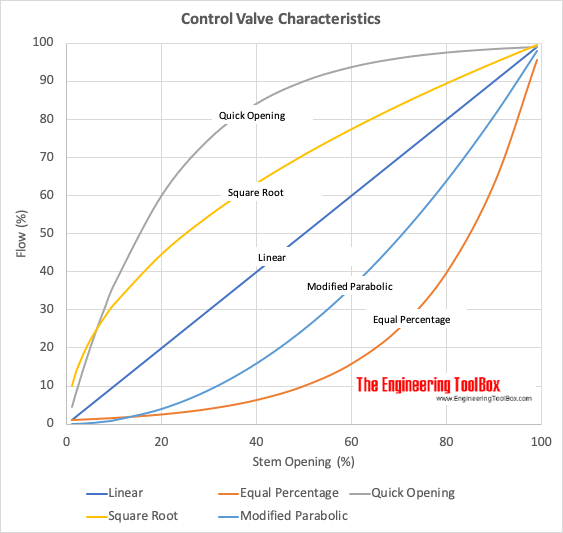Control Valves - Flow Characteristics
Flow capacities vs. stem opening.
The relationship between control valve capacity and valve stem travel is known as
- the Flow Characteristic of the Control Valve
Trim design of the valve affects how the control valve capacity changes as the valve moves through its complete travel. Because of the variation in trim design, many valves are not linear in nature. Valve trims are instead designed, or characterized, in order to meet the large variety of control application needs. Many control loops have inherent non linearity's, which may be possible to compensate selecting the control valve trim.

Inherent Control Valve Flow Characteristics
The most common characteristics are shown in the figure above. The percent of flow through the valve is plotted against valve stem position. The curves shown are typical of those available from valve manufacturers. These curves are based on constant pressure drop across the valve and are called inherent flow characteristics.
- Linear - flow capacity increases linearly with valve travel.
- Equal percentage - flow capacity increases exponentially with valve trim travel. Equal increments of valve travel produce equal percentage changes in the existing Cv.
- A modified parabolic characteristic is approximately midway between linear and equal-percentage characteristics. It provides fine throttling at low flow capacity and approximately linear characteristics at higher flow capacity.
- Quick opening provides large changes in flow for very small changes in lift. It usually has too high a valve gain for use in modulating control. So it is limited to on-off service, such as sequential operation in either batch or semi-continuous processes.
- Hyperbolic
- Square Root
The majority of control applications are with valves with linear, equal-percentage, or modified-flow characteristics.
Installed Control Valve Flow Characteristics
When valves are installed with pumps, piping and fittings, and other process equipment, the pressure drop across the valve will vary as the plug moves through its travel.
When the actual flow in a system is plotted against valve opening, the curve is called the Installed Flow Characteristic.
In most applications, when the valve opens, and the resistance due to fluids flow decreases the pressure drop across the valve. This moves the inherent characteristic:
- A linear inherent curve will in general resemble a quick opening characteristic
- An equal percentage curve will in general resemble a linear curve



